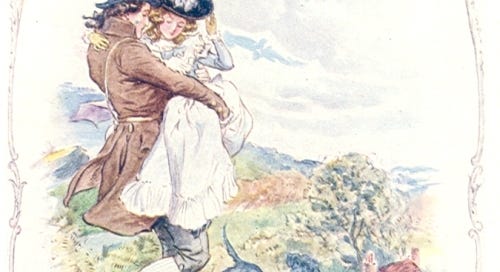Fans of the Netflix romp Bridgerton, or any of the Jane Austen film adaptations, will likely be familiar with the important social etiquette of inquiring after someone’s health. Unlike the modern throwaway how are you, people in the English Regency era had a genuine interest in the health of family and friends. Disease and infirmity were largely mysterious to the Regency mind, and whether your loved ones remained hale and healthy was seen as a matter of chance or, perhaps, divine caprice.
It was an age obsessed with illness, and with dubious cures such as ‘taking the waters’ at spa towns like Bath (thought to cure everything from frayed nerves to gout), taking laudanum (opium) routinely to help (mostly women) insomnia, and of course, bleeding patients for just about everything.
This is perhaps why Jane Austen, one of the earliest female novelists and the first to write engagingly about provincial gentry life, employed illness and injury frequently in her works. While readers can relate to her hypochondriac characters, dramatic head injuries, and the ever-present scourge of consumption (TB), one of the more puzzling representations of illness in her work involves rain, and its apparently near-lethal qualities.
In Austen’s most famous work, Pride and Prejudice, she reveals character and advances the plot with what was then called the ‘epidemic cold’, which caused stuffed noses and sore throats, as opposed to the more dangerous ‘putrid cold’, which is thought to have referred to diphtheria or strep throat.
When Jane Bennet is invited to dinner at nearby Netherfield House, where the rich, eligible bachelor Mr. Bingley is staying with his sisters and best friend, Jane’s scheming mother is overjoyed. She denies Jane permission to take the carriage, saying: ‘You must go on horseback, for it looks like rain, and then you will be forced to stay the night.’
Jane goes off obediently, and of course it starts to rain. She catches a cold, and not only has to stay the night, she becomes gravely ill and is bedridden for days. (Rain, it seems, is a remarkably swift villain, leaping from initial exposure to death’s door within hours.)
“Oh! I am not at all afraid of her dying. People do not die of little trifling colds.”
Mrs. Bennet, Pride and Prejudice
Jane’s illness prompts her sister Lizzie, (the heroine of the story), to rush to Netherfield, thereby forcing her and Bingley’s friend Mr. Darcy, (the hero), into each other’s company. It allows Lizzie to spar with Darcy during dull evenings of wine and whist, and leads to the couple discovering each other’s sparkling wit and sharp minds, a necessary step toward their falling in love.
It also gives Mrs. Bennet the chance to make of show of coming to her daughter’s side, and to commit some embarrassing faux-pas that further convince Darcy he could never marry into the Bennet family, no matter how passionate his feelings for the vivacious, captivating Lizzie.
Without Jane’s near-death in the rain, Lizzie and Darcy would not have begun the chase-and-withdraw love affair that unfolds with such charm and poignancy throughout the book.
Rain strikes again in another famous Austen work, Sense and Sensibility, in which two instances of rainfall bookend the tragic romance of Marianne Dashwood and John Willoughby.
Caught in a downpour, teenage Marianne takes a tumble and twists her ankle. Out of the storm comes Willoughby, a dashing gentleman who immediately comes to her aid. Marianne is dumbstruck by this paragon of manhood, and allows him to sweep her into his arms and carry her back home. In this case, the rain spared Marianne, and she is no worse for wear, with even ‘the pain of a sprained ankle disregarded’. Because naturally, she’s in love.
Readers follow the young couple as they read sonnets and make sly references to love and marriage, until Willoughby is on the verge of proposing but instead, to everyone’s shock, abruptly leaves for London and tells Marianne that he only ever felt friendship for her. We learn that he was forced to marry a wealthy heiress or else be cut off financially, and that like most gentlemen of the time, chose wealth over love.
Marianne’s heart breaks, and it is one of the most wrenching, tissue-worthy moments in all of literature. But in true Austen style, it’s not just Marianne’s heart that suffers.
Bereft and miserable, she goes for a walk so that she may look down upon the distant roofs of the estate where Willoughby now lives with his new bride. Storm clouds gather, and as the rain soaks her through, she collapses.
Colonel Brandon, a much older friend of the family who has loved Marianne from the moment they met, gallantly braves the rain himself to rescue her. This time, it’s Brandon’s arms that bear her home (at least in the 1995 film version).
“Two delightful twilight walks…(where the) grass was the longest and wettest, had—assisted by the still greater imprudence of sitting in her wet shoes and stockings—given Marianne a cold…”
Sense and Sensibility
Marianne develops a ‘putrid fever’, and for several days alternates between a ‘heavy stupor’ and wild delerium. Most of the other occupants of the house flee in terror of the ‘infection’ 5, but she recovers at last, and is now a changed woman.
No longer infatuated with Willoughby (or perhaps simply resigned to the fact that he is married and lost to her), she settles down into a quieter, more mature love and eventual marriage with Colonel Brandon.
Without the deadly influence of rainfall, Marianne would never have become infatuated with Willoughby, or then had her eyes opened to the true merits of Colonel Brandon. Without a brush with death, she never would have grown from a girl with stars in her eyes into a woman who learned to appreciate true love.
Scholars, physicians and readers alike have puzzled at the conflation of exposure to rain and serious illness in Austen’s work. We know that people of her time were unaware of how infections actually spread, and can easily be forgiven for trusting in old wives’ tales and superstitious beliefs. The problem remains, however, that Austen’s plots depend on her characters genuinely falling ill from nothing more than a good drenching.
If we are to truly immerse ourselves in the story, we have to accept that rain really can give you TB; to do this, most modern readers simply acknowledge that while rain itself has nothing to do with deadly infections, people in Austen’s time believed that it did.
The question is, then, how did they come to believe this? There are several possibilities.
Some researchers have speculated that since bacterial diseases like TB or pneumococcal pneumonia were widespread in Regency England, it may have been a matter of chance that someone who got a soaking also became infected at roughly the same time, and made the mistake of believing correlation equals causation. After all, the very thing that people did when finding shelter from the rain - usually huddling around a fire together drying off - provided the ideal conditions for the spread of disease.
Others have proposed that, although unlikely, perhaps getting cold and wet weakened the already sluggish immune systems of the undernourished population, to the point that someone who might have otherwise fought off an invading microbe succumbed to it instead. Of course, draining several pints of blood out of someone the moment they started to sniffle would only have made things worse.
But perhaps it’s best not to examine Austen’s choices from a purely scientific point of view. This was the age of the gothic horror, of girls swooning from fright, of doctors believing that restless uteri, roaming throughout the bodies of women who didn’t get pregnant often enough, were to blame for the ‘hysteria’ (named for the Greek word for the womb) of the weaker sex. Perhaps Austen was merely using rain as a convenient excuse for the illnesses that were necessary for her plots to unfold. Just as the thunder and lighting in the opening act of Macbeth set the stage for the tumultuous events to come, the rain storms in Pride and Prejudice and Sense and Sensibility can be seen as more of a symbol than anything; every downpour signals an irrevocable shift in direction in the heroines’ lives.
Jane may have set out fornlornly on horseback, but when she returned, in a carriage, with her mother and sister beside her, even she could have been in no doubt that her world had changed for having stayed at Netherfield. When Marianne Dashwood falls in love with Willoughby in one rainstorm, and finally says goodbye to him in another, her life alters course towards her ultimate destiny and, we hope, true happiness.









Share this post